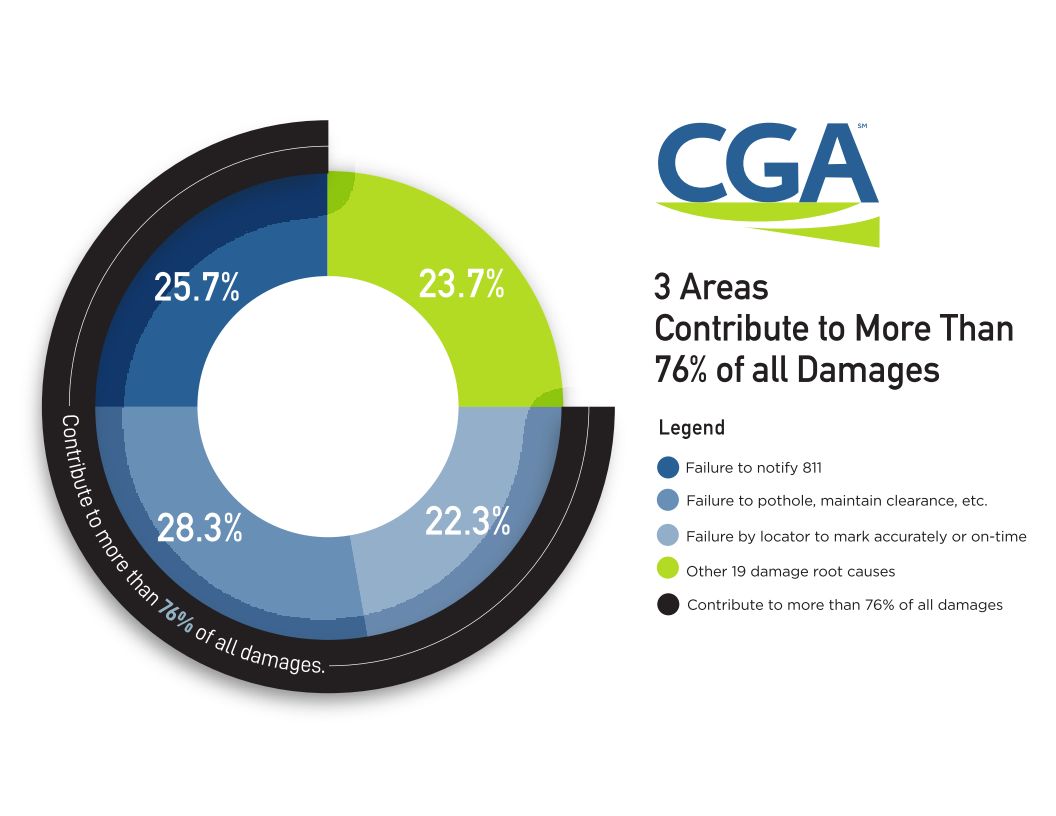Challenge to focus on advancing solutions to significantly reduce annual rate of incidents by addressing critical challenges, strategically focusing efforts on top damage drivers
Washington (Feb. 28, 2023) – Common Ground Alliance (CGA), the national nonprofit trade association dedicated to protecting underground utility lines, people who dig near them and their communities, today issued its “50 in 5” industry challenge to stakeholders with a goal of reducing damages to critical underground utilities by 50% in five years.
According to CGA’s Damage Information Reporting Tool (DIRT) Report, the annual rate of damages to buried infrastructure in the U.S. has remained stagnant for most of the last decade and costs the U.S. a staggering $30 billion every year. Each of the hundreds of thousands of dig-ins to underground utilities that occurs annually has the potential to cripple communities and businesses by cutting them off from critical services, cause injury or even loss of life.
CGA’s “50 in 5” challenge aims to address damages to our Nation’s critical assets head-on by bringing damage prevention advocates together around a targeted set of strategic, data-driven priorities. The “50 in 5” call-to-action encourages the damage prevention industry to concentrate on three focus areas that prioritize critical issues identified by CGA’s Next Practices Initiative and the top damage root causes that contribute to more than 76% of damages to buried infrastructure (according to CGA’s most recent DIRT Report):
- Effective and consistent use of 811: Despite DIRT data and market research which indicate that 811 awareness is very high – particularly among professional excavators – 60% of damages to underground utilities are caused specifically by professional contractors not contacting 811 prior to digging. CGA is unveiling a refreshed 811 tagline and animated logo this spring, which will join a new video seriesand other outreach tools that damage prevention advocates can use to implement behavior change campaigns around 811 usage.
- Key excavator practices (potholing, maintaining clearance, etc.): Potholing (test holing) to confirm the location of buried utilities and then maintaining the required clearance around those utilities, along with miscellaneous improper excavation practices, are key steps for protecting the integrity of underground infrastructure. Targeted and consistent excavator outreacharound these two CGA Best Practices (5.19 and 5.20) could dramatically reduce damages to buried infrastructure. CGA’s Next Practices Initiative also highlights damage reductions achieved by operators who contractually compensate excavators for potholing.
- Accurate, timely utility locating: CGA’s Locator White Paperand the work of the Next Practices Initiative reveal that improving the accuracy of facility maps and implementing electronic white-lining would help locators complete their work more quickly and accurately. Efforts like a Minnesota coalition’s pilot program to make 811 ticket-level facility map visualizations available to locators and other 811 system end users have the potential to increase locating efficiency, among other systemic benefits. Decreasing over-notification practices utilized by both contractors and facility owner/operators themselves would also help decrease overall 811 request volume so locators’ workloads are more manageable.
“The Common Ground Alliance’s damage prevention stakeholders have worked diligently to make communities safer by reducing dig-ins – but we are now at an inflection point as an industry,” said Sarah K. Magruder Lyle, president and CEO of CGA. “I encourage every stakeholder to meet our ‘50 in 5’ challenge and commit their organizations to making bold choices and investments as we look to cut annual damages in half by 2028. With the massive funding authorized by the Bipartisan Infrastructure Law and the pace of current construction activity, now is the time for the industry to seriously examine how we can make the next dramatic reduction in annual damages and protect critical infrastructure.”
“The CGA board of directors felt strongly that the industry must commit to taking concrete steps to significantly reduce damages to underground utilities,” said Josh Hinrichs, chair of CGA’s board and president of UtiliSource. “We must focus on taking damage prevention to the next level in order to keep our communities safe and connected to the utilities we depend on every day.”
With National Safe Digging Month set to kick off in April, CGA will be releasing a variety of new tools and outreach materials in line with the “50 in 5” call-to-action. The annual DIRT Report will continue to be the industry’s primary gauge of annual damages, and data and metrics collected by CGA’s Damage Prevention Institute will also help inform key interventions and strategies for damage reductions in the coming years.
For more information about CGA and annual damages to buried infrastructure, visit www.commongroundalliance.com and dirt.commongroundalliance.com.
About Common Ground Alliance
CGA is a member-driven association of more than 2,700 organizations representing every facet of the underground utility industry. Established in 2000, CGA is committed to saving lives and preventing damage to North American underground infrastructure by promoting effective damage prevention practices. CGA’s Damage Prevention Institute is focused on providing the industry with powerful insights and opportunities to reduce damages through a metrics-focused, peer-reviewed model. CGA has established itself as the preeminent source of damage prevention data and information in an effort to reduce damages to underground facilities in North America through shared responsibility among all stakeholders. For more information, visit CGA on the web at http://www.commongroundalliance.com.
